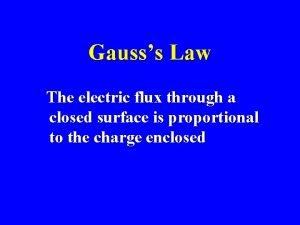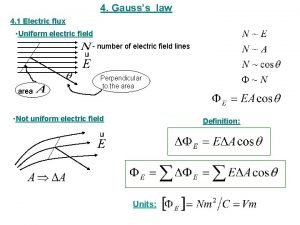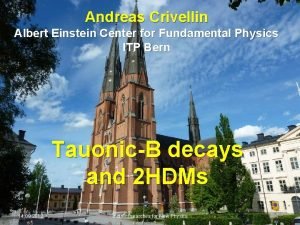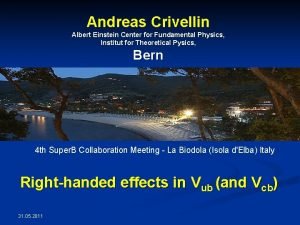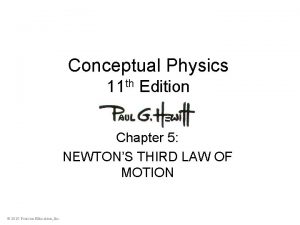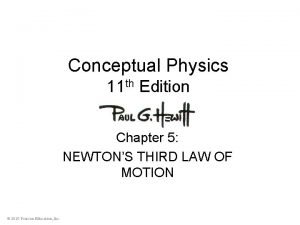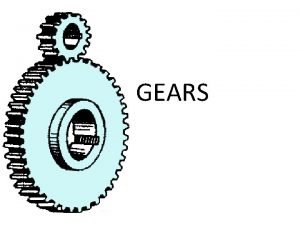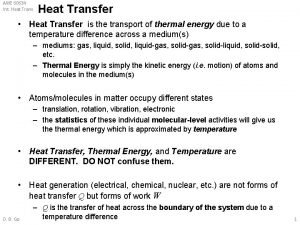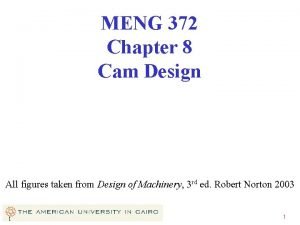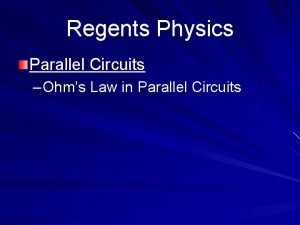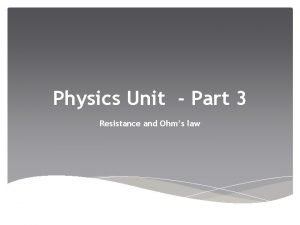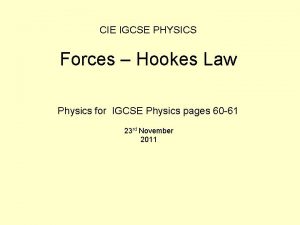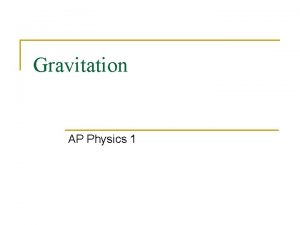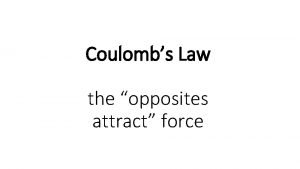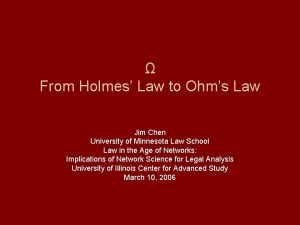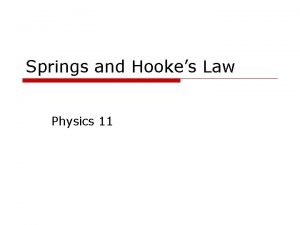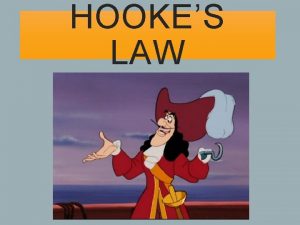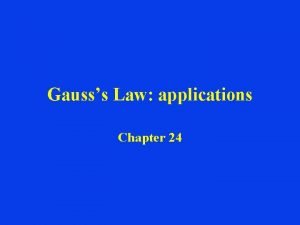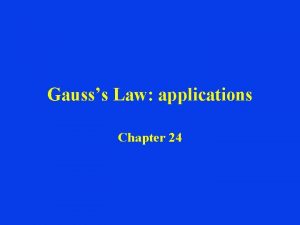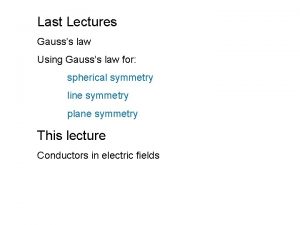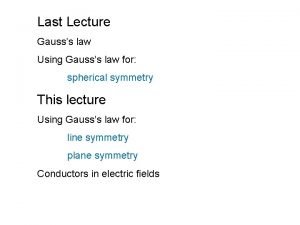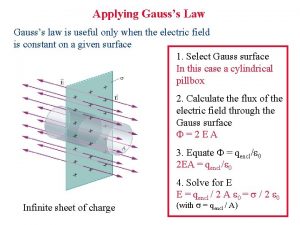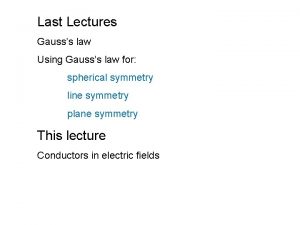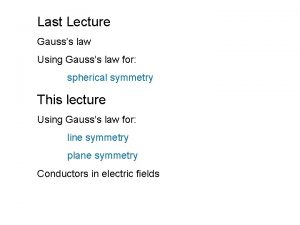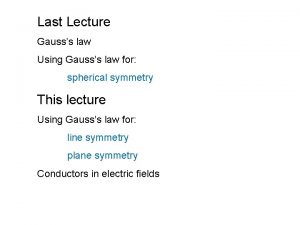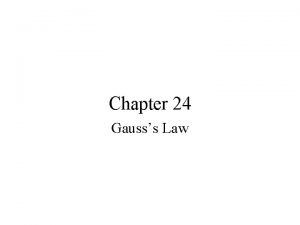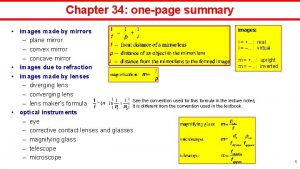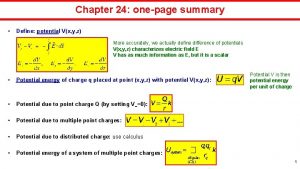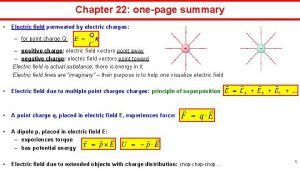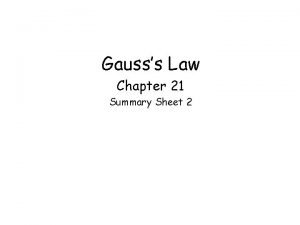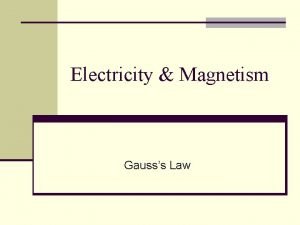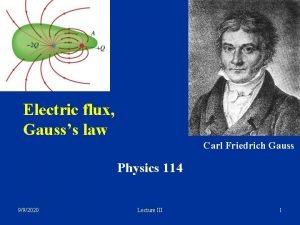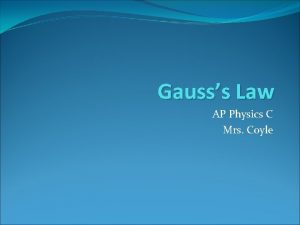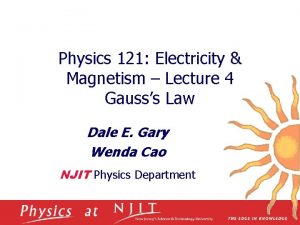Chapter 32 onepage summary Fundamental physics Gausss law


























- Slides: 26

Chapter 32: one-page summary • Fundamental physics: – Gauss’s law for non-existent magnetic monopoles – Maxwell: If d. B/dt makes E, can d. E/dt make B? Yes! – Four Maxwell’s equations, • capture ALL electromagnetism phenomena, • including the prediction of electromagnetic waves (next chapter) • Practical matters: – Magnetism sources (moving and spinning charges): • Earth magnetic field generating dynamo • electron’s orbital motion in atoms and the associated magnetic dipole moment • electron’s intrinsic spin and the associated magnetic dipole moment – Magnetic properties of materials • • paramagnetism diamagnetism ferromagnetism (including hysteresis, critical temperature) superconductors 1

Can one isolate magnet’s N or S poles? • Dipole field examples: Two point charges E Current loop B Permanent magnet B • The dipole field of a magnet bar is identical to the electric dipole field • Can one break off the North-pole piece from the rest of the magnet (similar to taking away a positive charge from an electric dipole)? 2

No, it does not work! • If one breaks a magnet, all one gets is two smaller dipole magnets • This makes sense if the permanent magnet is a sort of a solenoid, a collection of current loops If one cuts such a solenoid into two pieces, one ends up with two smaller solenoids, each of which makes its own dipole field. We will discuss how such permanent “current loops” can exist at the next lecture (it is quantum mechanics!) • All attempts to find magnetic monopoles (on earth, in cosmic ray particles or produced at the highest energy colliders) have failed… so far… 3

What we have learned so far (part A) 4

Example Problem One surrounds the north pole of a magnet with a Gaussian surface in the form of a cube. The flux of magnetic field through the top face of the cube is 2 Tm 2 and 1 Tm 2 through each of the four side faces. What is the flux through the bottom face? Answer: – 6 Tm 2 5

Example Problem Someone claims that a magnetic field in some region of space is (Bx, By, Bz)=(3 x, 1, 3). Prove that the claim is false. 6

HITT question A Gaussian surface in a form of a cube with side 1 m is placed in some region of space. It is found that – Magnetic field at the top cube’s face is constant: 1 T pointing upward. – Magnetic field at the bottom cube’s face is constant: 2 T pointing upward. What is the overall magnetic field flux through cube’s left-right-front-back surfaces in Tm 2? (A) 0 (B) 1 (C) -1 (D) 3 (E) -3 7

HITT question A Gaussian surface in a form of a cube with side 1 m is placed in some region of space. It is found that – Magnetic field at the top cube’s face is constant: 1 T pointing upward. – Magnetic field at the bottom cube’s face is constant: 2 T pointing downward. What is the overall magnetic field flux through cube’s left-right-front-back surfaces in Tm 2? (A) 0 (B) 1 (C) -1 (D) 3 (E) -3 8

What we have learned so far (part B) 9

Maxwell: can changing E make B? Nothing here? That’s OK: no magnetic monopoles imply no magnetic monopole currents either 10

Maxwell: can changing E make B? ? 11

Maxwell: can changing E make B? • Let’s do a common-sense thought experiment i closed loop (circle)

Four Maxwell’s equations no magnetic monopoles; hence, no currents made of monopoles 13

Sample problem A parallel plate capacitor with two plates of radius r 0 spaced by distance d has charge Q at time t=0. At this time, the capacitor is connected to a resistor with resistance R. Find the magnetic field magnitude in the plane between capacitor’s plates as a function of distance r from the center and time t. 14

HITT question Maxwell’s equations describe A. B. C. D. E. How electric and magnetic fields are produced Forces on electric charges due to electric and magnetic fields Both (A) and (B) A particular thought experiment I just woke up… What are Maxwell’s equations? 15

Atomic magnetic moments due to electrons’ L and S • An electron orbiting around a nucleus has an orbital angular momentum L and induces orbital magnetic dipole moment μorb • Quantum mechanics also predicts that electrons have an intrinsic unstoppable angular momentum, called spin S, and associated spin magnetic dipole moment μs Note: Electrons and protons have equal spins, but, due to the large mass difference, have very different spin magnetic dipole moments 16 (electrons have much larger dipole moment)

Permanent bar magnets Magnetic field of permanent bar magnets is due to the following mechanism: • Electron magnetic moments can be lined up by applying a strong external magnetic field • In certain materials (e. g. , iron), this alignment gets locked (via an intricate quantum mechanics effects) as long as temperature is smaller than some critical Tc (1043 K for iron) • A large number of small magnetic dipoles pointing in the same direction can give appreciable magnetic field 17

Earth – giant magnet SOUTH • Earth magnetic south pole is near geographic north pole • Earth magnetic north pole is near geographic south pole NORTH • Hence, compass’s north pole, – being attracted to the Earth magnetic south pole located up north, – points to the geographic north pole, – which explains the origin of the pole naming convention 18

Earth – giant magnet Earth magnetic field: How do we know about Earth magnetic field directions millions of years ago? – melted outer iron core is a conductor – mobility of electrons and positive ions differ greatly – core spins with Earth and there is also convection process (hot iron rises outward and cooled down iron sinks back downward) – Such motion of electric charges results in a dynamically-induced magnetic field – The process is self-sustained and intrinsically chaotic: field strength changes, the axis drifts and even flips over once in a while! 19

Navigation using Earth’s magnetic field • Compass made from magnetite was used in China since at least 1000 years ago Side note: not as accurate as contemporary gyroscopes and GPS, but needs no batteries! • Some bacteria are built like tiny magnets and rely the Earth magnetic field to orient themselves along the field and thus direct themselves downward into the mud at the bottom of ocean • Birds, bees, … feel the direction of Earth’s magnetic field and use this “sixth” sense in their navigation. How? We do not really know… • Can humans sense magnetic field—possibly, but very weakly and certainly not consciously… Research is ongoing… 20

Magnetic properties of materials (1) Reminder: Electric properties of materials – Assume that some charges make electric field E in some region in vacuum. – What happens to the electric field, if one fills that region with material? – Electric field gets reduced by a factor of kappa κ ≥ 1 (dielectric constant specific to the chosen material). – The reason behind this phenomenon: • either coherently aligned intrinsic dipole moments of molecules • or induced dipole moments in molecules, each of which is caused by the external electric field 21

Magnetic properties of materials (2) – Assume that something makes magnetic field B 0 in some region in vacuum. – What is the new magnetic field B in the region, if one fills it with some material? – The answer depends on the type of material • paramagnetic: • diamagnetic: B = μ B 0 (μ > 1) B = μ B 0 (μ < 1) • ferromagnetic: • superconductor: B = μ B 0 (μ>>1, e. g. 1000) + hysteresis! B = 0 (“ultimate” diamagnetic) – Intrinsic reasons in all cases are deeply rooted in Quantum Mechanics! However, qualitative consideration at the level of Classical Mechanics are quite insightful as well… 22

Paramagnetic materials • Materials (transition elements) in which orbital and spin magnetic moments of all electrons in an atom do NOT cancel out • Reaction on external magnetic field: – increase the field a little – attracted to strong field regions, when B field is not uniform • Classical physics interpretation of their properties: consider torques on atomic magnetic dipoles in external field and their consequent preferred orientation 23

Diamagnetic materials • Materials (majority) in which orbital and spin magnetic moments of all electrons in an atom cancel out • Reaction on external magnetic field: – the field is reduced – the object is repelled from strong field regions, when B field is not uniform • Classical physics interpretation of these properties: consider induced emf and forces in pairs of loops with orbital clockwise and counter-clockwise currents, as one brings in a magnet • • moving in A B Loop A: induced emf is in the same direction as the original current, so the current is increasing Loop B: the current is decreasing Hence, the net current in the pair of loops is now not zero, rather it points in the same direction as A Net result: a long stack of loop pairs AB-AB-… now looks like a solenoid: 1. whose filed is against the external field 2. whose North pole points left, and hence repels from the external bar magnet, i. e. repels away from strong field 24

Ferromagnetic materials (Fe, Co, …) • strong “couplings” between electrons of nearby atoms associated with their spins – electron spins spontaneously align – regions of constant alignment form small domains that act as tiny magnets – with an external magnetic field (H), one can force all domains to align globally and lock their overall field B permanent magnet • Hysteresis: • Tc (critical Curie temperature): – above Tc, thermal motion overcomes and destroys the locked alignment of electrons 25

Superconductors (Hg, Ni, …) • Materials that have zero resistivity (at very low temperatures) • Consider a block of superconductor in the place where there are no magnetic fields • An attempt to introduce B into the volume of superconductor, would create an infinite current • So the induced current is just such that magnetic field inside always remain ZERO • Superconductors are “ideal diamagnetic” material and are repelled from strong magnetic field regions 26
 Gausss law
Gausss law Flux
Flux Criao de site onepage
Criao de site onepage Newton's first law and second law and third law
Newton's first law and second law and third law Si unit of newton's first law
Si unit of newton's first law Boyles law
Boyles law Charles law constant
Charles law constant Albert einstein center for fundamental physics
Albert einstein center for fundamental physics Albert einstein center for fundamental physics
Albert einstein center for fundamental physics Conceptual physics chapter 5 newton's third law of motion
Conceptual physics chapter 5 newton's third law of motion Slightly tilted wings of airplanes deflect
Slightly tilted wings of airplanes deflect Gear tooth profile diagram
Gear tooth profile diagram Fundamental law
Fundamental law Fundamental law of cam design
Fundamental law of cam design Why does it happen
Why does it happen University physics with modern physics fifteenth edition
University physics with modern physics fifteenth edition Physics hl ia examples
Physics hl ia examples Parallel circuit laws
Parallel circuit laws What does resistance mean in physics
What does resistance mean in physics Hooke's law igcse physics
Hooke's law igcse physics Newton's universal law of gravitation ap physics 1
Newton's universal law of gravitation ap physics 1 State hooke's law in physics
State hooke's law in physics Opposites attract science law
Opposites attract science law Physics gauss law
Physics gauss law Holmes law electricity
Holmes law electricity State hooke's law
State hooke's law Hooke's law defines
Hooke's law defines
